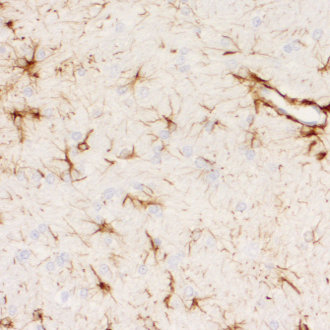
| Cat. No. 173 208 |
50 µg purified recombinant IgG, lyophilized. Albumin and azide were added for stabilization. For reconstitution add 50 µl H2O to get a 1mg/ml solution in PBS. Then aliquot and store at -20°C to -80°C until use. Antibodies should be stored at +4°C when still lyophilized. Do not freeze! |
| Applications | |
| Clone | Rb186C6 |
| Subtype | IgG1 (κ light chain) |
| Immunogen | full-length recombinant human GFAP (UniProt Id: P14136) |
| Epitop |
AA 1 to 15 from human GFAP (UniProt Id: P14136) |
| Reactivity |
Reacts with: human (P14136), rat (P47819), mouse (P03995), cow. Other species not tested yet. |
| Specificity | Specific for GFAP, detects all isoforms. K.O. validated |
| Matching control protein/peptide | 173-0P |
| Remarks |
This antibody is a chimeric antibody based on the monoclonal mouse antibody clone 186C6. The constant regions of the heavy and light chains have been replaced by rabbit specific sequences. Therefore, the antibody can be used with standard anti-rabbit secondary reagents. The antibody has been expressed in mammalian cells. |
| Data sheet | 173_208.pdf |

Glial fibrillary acidic protein GFAP is a glial-specific member of the intermediate filament protein family. This group comprises cell type-specific filamentous proteins with similar structure and function as scaffold for cytoskeleton assembly and maintenance.
Frequently, neural stem cells also express GFAP. In addition many types of brain tumors, probably derived from astrocytic cells, heavily express GFAP. This protein is also found in the lens epithelium, Kupffer cells of the liver, in some cells in salivary tumors and others.
Point-mutations in the GFAP gene have been correlated to Alexander disease, a fatal leukoencephalopathy that leads to the dysmyelination or demyelination of the central nervous system.
For more information on protein expression pattern, please refer to the overview image in our SYSY Antibodies ATLAS.